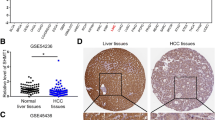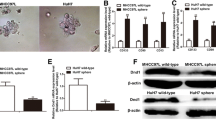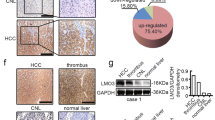Abstract
Na+/H+ exchanger 1 (NHE1), a primary regulator of intracellular pH (pHi) and extracellular pH (pHe), plays a significant role in acidifying the tumor microenvironment, possibly resulting in their malignant potential. However, currently, very little is known about the roles of NHE1 in invasion of hepatocellular carcinoma (HCC) cells. We have recently shown that NHE1 is over-expressed in HCC tissues and that this increased expression is associated with HCC invasiveness. In this study, we also found that NHE1 is over-expressed in HCC cell lines. Subsequently, we silenced NHE1 expression in the human HCC cell line SMMC-7721 using RNA interference (RNAi) and examined the invasiveness and proliferation of NHE1-silenced SMMC-7721 cells and the matrix metalloproteinase-2 (MMP-2) activity. The knockdown of NHE1 expression significantly inhibited the invasive ability of SMMC-7721 cells but had only a minor effect on the cellular proliferation rate. Moreover, NHE1 knockdown significantly reduced the secretion of MMP-2. Further experiment using amiloride (an inhibitor of NHE1) confirmed the above result. Together, these findings indicate that NHE1 has an important role in SMMC-7721 cell invasion and that NHE1 might be a new target of HCC treatment.





Similar content being viewed by others
References
Poon RT, Fan ST, Wong J. Risk factors, prevention, and management of postoperative recurrence after resection of hepatocellular carcinoma. Ann Surg. 2000;232:10–24.
Capocaccia R, et al. Hepatocellular carcinoma: trends of incidence and survival in Europe and the United States at the end of the 20th century. Am J Gastroenterol. 2007;102:1661–70.
El-Serag HB. Hepatocellular carcinoma: recent trends in the United States. Gastroenterology. 2004;127:27–34.
Murray CJ, Lopez AD. Mortality by cause for eight regions of the world: global burden of disease study. Lancet. 1997;349:1269–76.
Schafer DF, Sorrell MF. Hepatocellular carcinoma. Lancet. 1999;353:1253–6.
Makuuchi M, et al. Hepatic resection for hepatocellular carcinoma: Japanese experience. Hepatol Gastroenterol. 1998;45:1267–74.
Fan ST, et al. Hepatectomy for hepatocellular carcinoma: toward zero hospital deaths. Ann Surg. 1999;229:322–30.
Thorgeirsson SS, Grisham JW. Molecular pathogenesis of human hepatocellular carcinoma. Nat Genet. 2002;31:339–46.
Bruix J, Llovet JM. Prognostic prediction and treatment strategy in hepatocellular carcinoma. Hepatology. 2002;35:519–24.
Counillon L, Pouyssegur J. The expanding family of eucaryotic Na+/H+ exchangers. J Biol Chem. 2000;275:1–4.
Slepkov ER, Rainey JK, Sykes BD, Fliegel L. Structural and functional analysis of the Na+/H+ exchanger. Biochem J. 2007;401:623–31.
Malo ME, Fliegel L. Physiological role and regulation of the Na+/H+ exchanger. Can J Physiol Pharmacol. 2006;84:1081–95.
Boyer MJ, Tannock IF. Regulation of intracellular pH in tumor cell lines: influence of microenvironmental conditions. Cancer Res. 1992;52:4441–7.
Reshkin SJ, et al. Phosphoinositide 3-kinase is involved in the tumor-specific activation of human breast cancer cell Na+/H+ exchange, motility, and invasion induced by serum deprivation. J Biol Chem. 2000;275:5361–9.
Stock C, et al. Migration of human melanoma cells depends on extracellular pH and Na+/H+ exchange. J Physiol. 2005;225:225–38.
Rofstad EK. Microenvironment-induced cancer metastasis. Int J Radiat Biol. 2000;76:589–605.
Gatenby RA, Gillies RJ. Why do cancers have high aerobic glycolysis? Nat Rev Cancer. 2004;4:891–9.
Raghunand N, Gatenby RA, Gillies RJ. Microenvironmental and cellular consequences of altered blood flow in tumours. Br J Radiol. 2003;76:11–22.
Gillies RJ, Raghunand N, Karczmar G, Bhujwalla ZM. MRI of the tumor microenvironment. J Magn Reson Imaging. 2002;16:430–50.
Martinez-Zaguilan R, et al. Acidic pH enhances the invasive behavior of human melanoma cells. Clin Exp Metastasis. 1996;14:176–86.
Rofstad EK, Mathiesen B, Kindem K, Galappathi K. Acidic extracellular pH promotes experimental metastasis of human melanoma cells in athymic nude mice. Cancer Res. 2006;66:6699–707.
Klein M, Seeger P, Schuricht B, Alper SL, Schwab A. Polarization of Na+/H+ and Cl−/HCO3 − exchangers in migrating renal epithelial cells. J Gen Physiol. 2000;115:599–607.
Zeng ZS, Cohen AM, Guillem JG. Loss of basement membrane type IV collagen is associated with increased expression of metalloproteinases 2 and 9 (MMP-2 and MMP-9) during human colorectal tumorigenesis. Carcinogenesis. 1999;20:749–55.
Giannelli G, et al. Human hepatocellular carcinoma (HCC) cells require both alpha3beta1 integrin and matrix metalloproteinases activity for migration and invasion. Lab Invest. 2001;81:613–27.
Kato Y, Nakayama Y, Umeda M, Miyazaki K. Induction of a 103-kDa gelatinase/type IV collagenase by acidic culture conditions in mouse metastatic melanoma cell lines. J Biol Chem. 1992;267:11424–30.
Bourguignon LY, Singleton PA, Diedrich F, Stern R, Gilad E. CD44 interaction with Na+/H+ exchanger (NHE1) creates acidic microenvironments leading to hyaluronidase-2 and cathepsin B activation and breast tumor cell invasion. J Biol Chem. 2004;279:26991–7007.
Lagana A, et al. Regulation of the formation of tumor cell pseudopodia by the Na+/H+ exchanger NHE1. J Cell Sci. 2000;113:3649–62.
Acknowledgments
We thank all other members of our laboratory for their insight and technical support. This work was supported by grants from the National Natural Science Foundation of China (No. 30872480) and Shanxi Province Natural Science Foundation of China (No. 2008K09-05).
Author information
Authors and Affiliations
Corresponding author
Additional information
Xuekang Yang and Desheng Wang contributed equally to this work and should be considered as co-first authors.
Rights and permissions
About this article
Cite this article
Yang, X., Wang, D., Dong, W. et al. Suppression of Na+/H+ exchanger 1 by RNA interference or amiloride inhibits human hepatoma cell line SMMC-7721 cell invasion. Med Oncol 28, 385–390 (2011). https://doi.org/10.1007/s12032-010-9447-x
Received:
Accepted:
Published:
Issue Date:
DOI: https://doi.org/10.1007/s12032-010-9447-x




